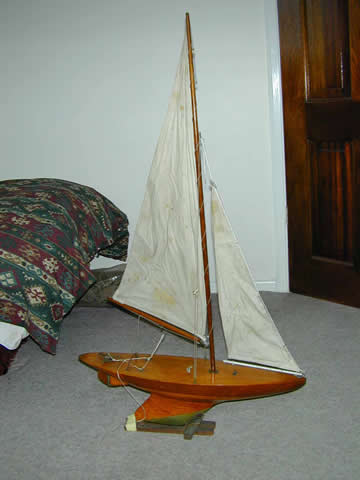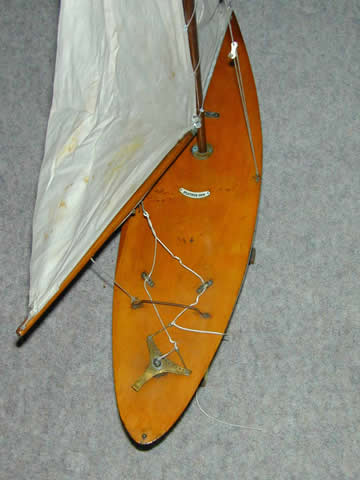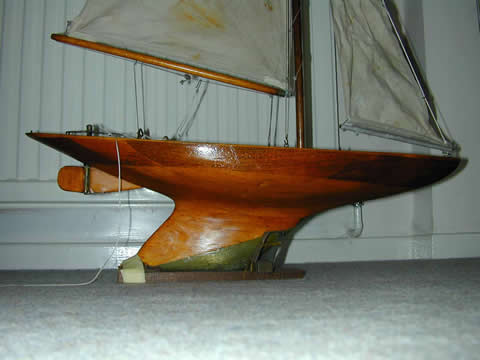I will be most interested to know if you can identify
the attached model yacht.
It was bought in Bradford about 1940. It is named Heather Dew and I know there
were 2 other similar models available one being smaller and one being larger.
My yacht is 24" long 6" beam 35" mast. Built with laminated
hull.
It was a special thing to buy in those times when Mother was the all provider
and money was scarce.
It was my pride and joy when I was 7 and still looks great to me. Can you
tell me anything about the makers and type of yacht or quality.
I have gone on to build racing dinghies and in spite of being a non swimmer
I have raced then. But I am past that now and thought I would build a model
yacht, the idea of getting free motive power always appeals. Can you suggest
whether I would be better to start with a 2nd hand hull and refurb it or build
from scratch. I am not intending to compete, I will only do it for my personal
satisfaction. Presumably I would be better to go to radio controlled systems.
MW



Reply from Russell
Potts
What you have is an example of a one of
a series of very superior toy boats made by Alexanders of Preston. They operated
in the interwar period and after the war until about 1960. The father was
a patternmaker and wooden shipwright and was employed by Fife of Fairlie before
1914. During the 1914 war he worked on flying boats in one of the S coast
aircraft works. (Saunders?). After that the family settled in Preston where
the father must have had some sort of woodworking business as well as his
model yacht building. He designed and built some very serious class racing
models including a series of A Class boats, all called White Heather. His
two sons won the International contest for the Yachting Monthly cup with No
8 in 1939.
The toys came in a range of sizes from 18 inches to 36 inches and were all
essentially similar in form and derived from one of Alexander's 6-metre models.
There were two styles. One that was the early model had a fin that was longer
(chordwise) than yours and a rudder that drooped slightly from the skeg. Just
like a 1930's Alexander 6-m. The later style, like yours, had a shorter, more
vertical fin and the rudder was horizontal from the skeg. I had always assumed
that the second style was introduced after 1945 when they got back into models,
but if yours does indeed date from 1940, the change was made earlier.
Over the years there were minor variations in the fittings and spars, with
aluminium masts being found on some 1930s examples, then wood like yours and
then alu again in the late production. All the boats were named, a name for
each size of model, and almost all reflected the Scottish origins of the family.
These boats are much sought after by collectors. This doesn't mean she can't be sailed! just don't
drop her on the concrete. From the photos it doesn't look as if she needs
more than a fresh coat of varnish before you go sailing again.
As to your future plans for a model that would be a bit bigger and suitable
for radio, you would probably do better to build afresh. If you are attracted
by older styles of model, the Vintage Group can offer a wide range of plans
dating from the mid 19th century onwards. We can also advise on the best way
to get radio into boats that aren't designed for it. If you want something
a bit more up to date, have a look at the plans offered by Traplet, who publish
Marine Modelling International They have a web site, but I'm not sure if there
is much detail of their plan offerings on it. The Curved Air Press, which
I also run, offers specialist titles on model yachting, including a good text
on plank on frame building.
Russell Potts
Chairman VMYG
I would also suggest
that you contact a local model boat club and see what they sail. Even though
you don't want to race it may help you get the feel of different types of
boat and modelling. MJ
| 